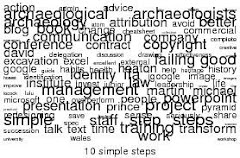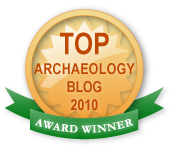They tell us that the recession is over. Over the next few years, the rate of development will increase, and commercial archaeology will be back in business, and even if it doesn't reach the frantic heights of the recent gold rush, curatorial archaeologists will be kept busy (unless a new government decides that heritage is an impediment to economic growth). There is now a breathing space in which curators have a chance to consider whether any chnages in approach are needed. I think the answer is yes, based on how it worked before (excessive documentation, delays in response, inconsistency), but also because of changes that can be foreseen. The next decade will see a revival in construction and its associated archaeological activity at the same time as savage cuts in local government budgets, falling especially heavily on non-statutory functions. It will be a lucky curatorial service that retains its current staff while facing a doubled workload. Something's gotta give - but what? An answer which would work would be a shift to light-touch regulation. The Corgi gas servicing scheme had training and accrediation for workers, but very limited inspection of work done. Maybe this is a model that could be considered for archaeology. What would this entail in practice?
Trusting the record
In assessing the possible impact of a development on archaeology, it is possible to spend an enormous amount of time wondering "if there's a flint over there, and a flint in that field, surely there must be a henge here?", or "Fred's been fieldwalking round there for years - I wonder if he's got anything in his notebooks?", or "I'll just check the early OS map and the tithe map and the APs to see if anything turns up". You should rely on the HER to tell you where the known arcaheology is. If the rason you can't is because the HER is an inadequate record of known arcaheology, then you should a) hang your head in shame that after 35 years it still isn't doing what it was supposed to do, and b) invest significant resources in enhancing it.
Focusing on important stuff
Every development might affect archaeology, known or unknown. These days, Total Archaeology runs up to the present, so any development will have an affect - removing a fecne or a lamp-post. Obviously we cannot hope to save, monitor or record it all. There will be losses. Focus on the major stuff - big holes in important sites.
Relying on Standard Operating Procedure
Don't re-invent the wheel. Almost all of curatorial and contractual archaeology involves applying a standard set of principles and practices to the specific requirements of an individual development. Most of these principles and practices are shared with the rest of the UK archaeology community, so you should think twice befoe developing local variants, and three times before tailoring them to single projects. There's no shame in saying "do the same as usual".
Trusting the contractor
The contractor is being paid to examine in great detail the development, to identify the main impacts, think about the arcaheological effects, and devising a programme of mitigation. They are being paid to prvide a professional service. Let them. If they are accredited orgaisnations or people, they have passed a gatekeeper test and are subject to monitoring by the IfA. You don't need to check whether they have costed for Portaloos or have chosen the right Roman pottery specialist. So don't check. Reserve the right to inspect if you wish, but do so sparingly.
Communicating quickly
Telephones eat time. Writing eats time. Handle all possible communications by email: a one-sentence message confirming a spec can be written in 10 seconds (after allowing 5 minutes to scan through the key archaeological elements). If you get FAQs from developers or planners, put a FAQ page on the website or send it to them.
Don't stretch a point
What also eats up time is arguing about things like landscape character. Preparing an argument takes a long time if you are having to justify a largely arbitrary and personal view. So don't do it. If you have managed to protect the hard archaeology then you've done the most important part of your job. Heritage has become an easy piece of ammo for NIMBYs, leading you into controversies in which the impacts on archaeology are negligible. Any time that you find that you are having to do a lot of research before you can comment, you're probably trying too hard to find something to complain about.
I for one will not accept any claims from curators that they are under-reseourced and over-worked unless they can claim to have followed the above. Yes, it's hard work, but it's your job, so get on with it.
Saturday 28 November 2009
Curatorial practice after the crunch
Posted by
Martin Locock
at
11:10
0
comments
![]()
Labels: crunch
Thursday 12 November 2009
CPD: no more excuses
Fairly quietly, and fairly uncontroversially, the IfA has just transformed the way that professional archaeologists must behave, by making it compulsory for their members to undertake 25 hours of CPD a year in line with a Personal Development Plan [templates for CPD log and PDP available on their site]. From a vague statement in the code of conduct that archaeologists have a duty to keep themselves well-trained and informed, identifying training needs and fulfilling them has become one of the key responsibilities of a professional worthy of the name. This is good news - I believe that those who claim to be unable to locate any skill gaps either are already in fact managing a lot of CPD or haven't thought about it enough, or at all. They should start with my Action Plan.
The impact of the rule change will vary - in organisations which are Investors In People , employees will already have PDPs which cover both employment-focused and personal development. For others, employers will probably have to accept that training their staff is something they will have to do, and possibly pay for.
But what if the employer can't or won't. Here are some suggestions for CPD activities that will cost little or nothing but will have a instant payoff:
* read the legislation and guidance - Planning Policy, the Copyright Designs and Patents Act, the Ancient Monuments and Archaeological Araes Act, the Valetta Convention, Environmental Information Regulations. These are quite interesting once you get into them, and will equip you with a much better grasp of the overall context of your work.
* Time management - Read Getting Things Done and implement it; make an iGoogle homepage ; or just read some advice online.
* Read some journals. Medieval Archaeology, PPS, Britannia, and Post-Medieval Archaeology contain interesting book reviews and reports as well as excavation accounts - now reading them is work.
* Attend one or two day-schools or events. Maybe ones you wouldn't normally go to.
* Generic skills: negotiation, assertiveness, project management, team leadership, effective meetings, report writing.
* Presentation skills: Powerpoint, html, Word
* Master digital photography - find out what ll those buttons actually do, nd see if you can take some photos that show what they are supposed to
That should keep you busy for the first two or three years.
Posted by
Martin Locock
at
23:06
0
comments
![]()
Labels: training






